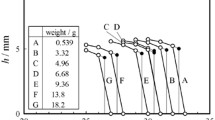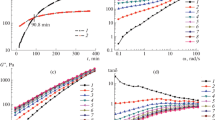Abstract
A broad temperature range of the gel–sol transition of κ-carrageenan was precisely examined by differential scanning calorimetry (DSC), thermomechanical analysis (TMA) and the falling ball method (FBM). κ-Carrageenan the transition temperature of which ranged from 290 to 350 K was used as a representative sample of a thermo-reversible hydrogel. The starting of transition attributed to dissociation of the weak cross-linking zone of aggregated double helices was detected as a change of expansion coefficient by TMA and as an endothermic deviation by DSC. Peak temperature of endotherm by DSC agreed well with the temperature where expansion changed from positive to negative value and this temperature was attributed to gel–sol transition caused by dissociation of double helices’ assembly. Transition temperature measured by FBM was observed at a temperature higher than those obtained by DSC and TMA, which was attributed to decomposition of double helices.









Similar content being viewed by others
References
Desbrières J, Hirrien M, Rinaudo M. A calorimetric study of methylcellulose gelation. Carbohydr Polym. 1998;37:145–52.
Nishinari K, Hofmann KE, Moritaka H, Kohyama K, Nishinari N. Gel–sol transition of methylcellulose. Macromol Chem Phys. 1997;198:1217–26.
Iijima M, Hatakeyama T, Takahashi M, Hatakeyama H. Effect of thermal history on kappa-carrageenan hydrogelation by differential scanning calorimetry. Thermochim Acta. 2007;452:53–8.
Hatakeyama T, Dohjima M, Onishi T, Hatakeyama H. AFM and DSC studies on gelation of methyl cellulose mixed with sodium cellulose sulphate. In: Williams PA, Phillips GO, editors. Gums and stabilisers for the food industry 14. Cambridge: Royal Soc Chem; 2008. p. 446–53.
Iijima M, Hatakeyama T, Takahashi M, Hatakeyama H. Thermomechanical analysis of polysaccharide hydrogels in water. J Therm Anal Calorim. 2001;64:617–27.
Iijima M, Hatakeyama T, Nakamura K, Hatakeyama H. Thermomechanical analysis of calcium alginate hydrogels in water. J Therml Anal Calorim. 2002;70:807–14.
Iijima M, Hatakeyama T, Nakamura K, Hatakeyama H. Effect of annealing on calcium pectin gel formation by thermomechanical analysis. J Therm Anal Calorim. 2002;70:815–24.
Iijima M, Hatakeyama T, Hatakeyama H. Swelling behaviour of calcium pectin hydrogels by thermomechanical analysis in water. Thermochim Acta. 2005;431:68–72.
Watase M, Nishinari K. Dynamic viscoelasticity and anomalous thermal behaviour of concentrated agarose gels. Makromol Chem. 1987;188:1177–86.
Watase M, Nishinari K. Rheological and thermal properties of carrageenan gels. Effect of sulfate content. Makromol Chem. 1987;188:2213–21.
Nishinari K, Watase M, William PA, Phillips GO. κ-Carrageenan gels: effect of sucrose, glucose, urea, and guanidine hydrochloride on the rheological and thermal properties. J Agr Food Chem. 1990;38:1188–93.
te Nijenhuis K. Thermoreversible networks: viscoelastic properties and structure of gels. Adv Polym Sci. 1997;130:5–252.
Park J-S, Ruckenstein E. Viscoelastic properties of plasticized methylcellulose and chemically crosslinked methylcellulose. Carbohydr Polym. 2001;46:373–81.
Pelletier E, Viebke C, Meadows J, Williams PA. Solution rheology of κ-carrageenan in the ordered and disordered conformations. Biomacromol. 2001;2:946–51.
Anderson NS, Campbell JW, Harding MM, Rees DA, Samuel JWB. X-ray diffraction studies of polysaccharide sulphates: double helix models for κ- and ι-carrageenans. J Mol Bio. 1969;45:85–8.
Thành TTT, Yuguchi Y, Mimura M, Yasunaga H, Takano R, Urakawa H, Kajiwara K. Molecular characteristics and gelling properties of the carrageenan family, 1. Preparation of novel carrageenans and their dilute solution properties. Macromol. Chem Phys. 2002;203:15–23.
Berth G, Vukovic J, Lechner MD. Physicochemical characterization of carrageenans—A critical reinvestigation. J Appl Polym Sci. 2008;110:3508–24.
Mangione MR, Giacomazza D, Bulonea D, Martorana V, San Biagio PL. Thermoreversible gelation of κ-carrageenan: relation between conformational transition and aggregation. Biophys Chem. 2003;104:95–105.
Kara S, Tamerler C, Bermek H, Pekcan Ö. Hysteresis during sol–gel and gel–sol phase transitions of κ-carrageenan: a photon transmission study. J Bioactive Compat Polym. 2003;18:33–44.
Mahmood SJ, Bi F, Taj N, Farhan M, Shahid M, Azmat R, Uddin F. Physica-chimical characterization of carrageenan ad different tempertures, isolated from Hypnea musciformis from Karach coast Pakistan. J Appl Sci. 2007;7:3506–77.
Tanaka R, Hatakeyama T, Hatakeyama H, Phillips GO. Differential scanning calorimetric studies of Philippines natural grade κ-carrageenan. Food Hydrocoll. 1996;10:441–4.
Hilliou L, Larotonda FDS, Sereno AM, Goncüalves MP. Thermal and viscoelastic properties of κ/□-hybrid carrageenan gels obtained from the Portuguese seaweed mastocarpusstellatus. J Agric Food Chem. 2006;54:7870–8.
Piculell L. Gelling carrageenans. Food Sci Technol. 1995;67:205–44.
Hoare TR, Kohane DS. Hydrogels in drug delivery: progress and challenges. Polymer. 2008;49:1993–2007.
Kara S, Tamerle C, Bermek H, Pekcan Ö. Cation effects on sol–gel and gel–sol phase transitions of k-carrageenan-water system. Inter J Biol Macromol. 2003;31:177–85.
Kara S, Arda E, Kavzak B, Pekcan Ö. Phase transitions of κ-carrageenan gels in various types of salts. J Appl Polym Sci. 2006;102:3008–16.
Smidsrød O, Grasdalen H. Some physical properties of carrageenan in solution and gel state. Carbohydr Polym. 1982;2:270–2.
Acknowledgements
The authors are grateful to Professor Clive S. Langham, Nihon University, for his helpful comments and advice. This work was supported by a Grant from the Otsuma Kotaka Foundation and a Grant-in-Aid for Scientific Research (Young Scientists (B)).
Author information
Authors and Affiliations
Corresponding author
Appendix
Appendix
In order to obtain reliable results by FBM, preliminary experiments were carried out using 1 % κ-carrageenan hydrogel. Figure 10 shows the relationship between the height of the steel ball and temperature. Steel balls having various sizes as described in the experimental section were used. As shown in Fig. 10, when the size of the steel ball is in a range from 0.8 to 1.5 mm, the height of the steel ball sharply decreases at about 316 K. When the steel ball size was 0.5 mm, the ball moved gradually, indicating the mass of the ball was too light.
Figure 11 shows the relationship between gel–sol transition temperature of 1 % κ-carrageenan hydrogel and size of the steel ball. T g−s of 1 % κ-carrageenan hydrogel maintains a constant value, regardless of the size of the steel ball. From the above results, FBM measurements were carried out using a 0.8-mm steel ball.
Rights and permissions
About this article
Cite this article
Iijima, M., Takahashi, M., Hatakeyama, T. et al. Detailed investigation of gel–sol transition temperature of κ-carrageenan studied by DSC, TMA and FBM. J Therm Anal Calorim 114, 895–901 (2013). https://doi.org/10.1007/s10973-013-2953-2
Received:
Accepted:
Published:
Issue Date:
DOI: https://doi.org/10.1007/s10973-013-2953-2






